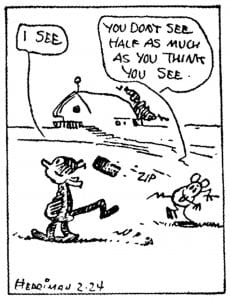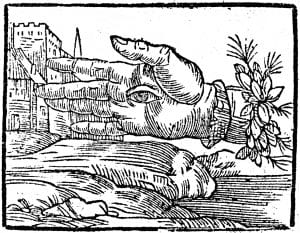
This collection of essays is grouped around categories that, in turn, represent stages of thinking and production that moved, from early interests in representation, virtuality (of shadows), and Vico’s importance for architecture theory to landscapes (Surrealist), anamorphosis, temporality, fictional forms, cinema, and back around again to virtualities. The thought of Lacan began to make itself felt around 2014, when I began to attend conferences on psychoanalysis (LACK, ACSA, APW, APPI, Éncore) and host or attend zoom seminars on the architectural imagination, the alethosphere, and the Stendhal Syndrome. Ultimately, the project of consolidating Lacanian literature around extimité (Jacques-Alain Miller) and anamorphosis (Mladen Dolar) summarizes my final desire, to see each of these meta-themes in terms of the other.
The unsung or at least lesser-sung praises for projective geometry require a theoretic orthography — a correction of the thematic that dominated architecture theory for nearly 25 years, based on a dichotomy first elaborated by the French historian-critic Paul Hazard (The Crisis of the European Mind, 1680–1715). Based on the Cartesianism popular in the 17c., this historicism was popular among Vichians in particular, if only because Vico himself developed a radical historicism of three fundamental stages of thought evolved in all cultures. But, Vico would have seen the science–art binary as a symptom of his third stage, one of the conceits of the mind in its last stages. Vico argued for scholarly heroism, in his essay De mente heroica (“On the Heroic Mind”). Knowing in advance that one cannot

describe this methodology literally, Vico provided a “proof of the body” through his own writing, which appears at first to be crippled by digression, repetition, circularity, and gaps. In short, Vico’s major work, The New Science, is a torus that, on one hand, appears to be inflatable in the usual sense that words are expanded within a skin to create a stable form. On the other hand, the “New” in New Science is as little about modern thinking as Dante’s Nova Vita was about a fresh start. In Latin more than Italian, Nova is 9, and 9 is notorious for being able to slip in and out without being noticed. This is not a claim about numerology but rather rhetoric. What gets in and out w

ithout being noticed in Vico’s works is his idea of the middle term, the rhetorical enthymeme, capable of turning from one condition or type to its opposite.
If anything could be said to join the following collection, it would be the middle term, the dynamics of the gap or void that, in architecture and topology, are cause for the presence of a second space, Real only in that it is virtual, virtual only in that it is second to the kind of virtuality that balances out the perspective picture. This second virtuality plays by the rules of geometry, the kind discovered by Pappus of Alexandria in 300 a.d., re-discovered by Girard Desargues and Blaise Pascal in the 17c., forgotten again but revived with an enthusiasm sufficient to fill an entire century, the 19th. Again, it is forgotten and its genius-inventors reviled (only by architecture theorists). The wish to play Howard Rouark, hero of The Fountainhead, the manic novel by the alt-right novelist Ayn Rand, has infected theory as well as practice, and much of contemporary writing is polemical rage.
My writing is original possibly only in the connections of extimité, anamorphosis, and the middle term to the (normally) mathematical idea of idempotency, summarized by the non-intuitive formula of x + x = x. Idempotency is the elevator button that, no matter how many times you push it the elevator will not come any faster but it will tell you about your desire. The self-reflexivity of idempotency, and the ability of topology to map its methods and effects, is new to both psychoanalysis and architecture theory. Forgive me if I have not worked out all the details yet.
Writing is not the key to truth but it is essential to the desire for truth, where one does not “find” or “possess” the truth but truth, if she wishes, may be generous enough to paralyze thought while writing continues, mimicking the horror film motif of the severed hand of the pianist that continues its mazurkas and polonaises.* Automatism and autism are similar in that neither cares about the reader’s peace of mind but automatism cares significantly about commotion, as much as the autistic is able to generate it. The middle term is, for Vico, “silent” or “mute,” and it’s good to remember that mythos and “mute” are etymological twins. Vico elaborated the idea of a “silent mental language,” which in Lacan-world would be the master signifier, particularly in its manifestation as metaphor, where silence becomes latency and latency becomes the somersault of signifier and signified on behalf of meaningfulness over the endless chaining of meanings.
on the way to an anamorphosis/extimité blend
• Works on anamorphosis/orthography
• Works on Topology in the Landscape and Architecture
• Works about Architecture and the Landscape
• The Zairja: A Reverse Thinking Machine
• DIAGRAMS: Frame Theory, Énoncé, and Aristotle’s Cause Schema
• SHORT WORKS: Labyrinths, Fourth Walls, Positions, Footnotes